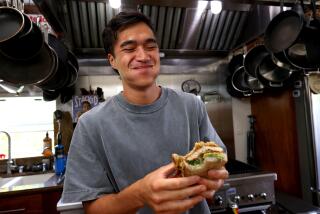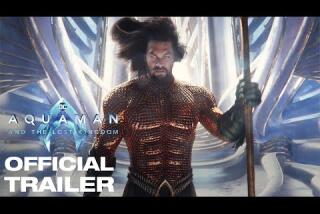‘Fast & Furious: Hobbs & Shaw’s’ Jason Statham addresses justice for Han
- Share via
With this weekend’s box office-topping release of “Fast & Furious” spinoff “Hobbs & Shaw,” Jason Statham’s Deckard Shaw has been firmly reborn as the franchise’s “misunderstood” hero. But Justice for Han is coming, promises Chris Morgan, writer-producer of the hit series.
What is #JusticeForHan? It’s the rallying cry parts of the fandom have championed since British special-ops assassin Shaw took an abrupt turn-to-the-good in the eighth film, “Fate of the Furious,” and a piece of “Fast” history fans refuse to forget.
That’s because if there’s a single defining moment for Shaw in the beefiest franchise on the planet, it’s the villainous act that introduced him at the end of 2013’s “Fast & Furious 6.”
The surprise cameo revealed Shaw as the mysterious figure responsible for the fiery car wreck that killed fan fave Han Seoul-Oh (Sung Kang) in 2006’s “Fast & Furious: Tokyo Drift.” It set the stage for a showdown in which Shaw was the big bad bent on destroying Dom Toretto’s crew in “Furious 7.”
“Well, look. All we saw was a snapshot of something. We don’t know exactly what happened. We don’t know the full story!” Statham said shortly before the release of “Hobbs & Shaw,” accepting the asterisk that remains on his character’s canonical ledger.
In the “Fast” universe, the classic ideals of family and loyalty have long reigned supreme, woven into the films’ savvy marketing campaigns and heartily embraced by fans. But four words have haunted fans who hold dear the sacred principles of “ride or die”: Deckard Shaw killed Han.
Several franchise turns later, Shaw is — surprise! — now one of the heroes of the first “Fast” spinoff, in which he trades bickering barbs with Dwayne Johnson’s lawman Luke Hobbs as they team up to save the world. (Statham and Johnson are also producers on the film.)
And yet: Deckard Shaw killed Han. Maybe don’t hand him a Corona just yet.
“It’s clearly something that needs to be addressed,” Statham said jovially by phone from London, prepared to face the music. “And we can build out upon that.”
Even in a fictional world filled with skydiving cars, shifting alliances, soapy machismo and increasingly bombastic stunts, this canonical detail regarding the fate of a beloved supporting character has tested the bounds of disbelief more than any other earthly impossibility attempted onscreen.
Shaw hasn’t yet apologized for it, either, a nagging incongruity in a franchise with a defining code of honor among racers, thieves and spies. After all, Dom Toretto doesn’t have friends. He’s got family. And Han, still the most prominent character of Asian descent in the inclusive “Fast” movies, was family.
We don’t know exactly what happened. We don’t know the full story!
— Jason Statham on #JusticeForHan
The “family” mantra has defined the “Fast” franchise since it exploded from the relatively humble bromantic beginnings of 2001’s “The Fast and the Furious,” a gritty, L.A.-set B movie starring Vin Diesel and the late Paul Walker as racers who find brotherhood from opposite sides of the law.
Sequels pushed the series to increasingly turbocharged heights, assembling a multicultural cast of international antiheroes and bringing ever more mythical, over-the-top action to life. The “Fast and Furious” series swelled into a $5 billion-plus grossing property worldwide partly because it experimented with traditional franchise-building while preserving its brand identity; when Walker tragically died in 2013, filming of “Furious 7” was halted and his character’s arc rewritten into an emotional farewell, carrying the notion of family beyond the screen.
After that Universal sped ahead with an ambitious expansion of the “Fast” mythology, diving deeper into twisty techno-spy plot lines, bringing in new villains like Charlize Theron’s Cipher, and exploring further potential spinoffs including “Hobbs & Shaw,” an animated series and the potential female-led installment Diesel teased in January.
Then a redemption arc written into the eighth film, “Fate of the Furious,” earned Shaw an invite to the family cookout. That led to “Hobbs & Shaw,” in which he’s fully ascended to hero status, reconnecting with his MI6 agent sister, Hattie (Vanessa Kirby) at the behest of their mother (Helen Mirren) to take down ex-pal turned cybernetically enhanced supervillain Brixton Lorr (Idris Elba).
Whither justice for Han?
Statham defended Shaw’s actions in Tokyo. “It was for a good cause!” he joked, arguing that from where Shaw was standing during the events of “Furious 6,” Toretto’s gang looked like the bad guys because they put his brother, mercenary villain Owen Shaw (Luke Evans), in the hospital.
The action star had concerns about how Shaw would be developed while in talks for that “Fast 6” cameo, he said. “There was something about the intention of the bad guy in that movie, which happened to be [Deckard’s] brother [Owen Shaw],” he explained. “It just didn’t resonate with the character that I wanted to play.
“Despite all the recommendations to do ‘Fast 6’ — ‘Oh, you need to do this,’ ‘It’s good for you,’ ‘It’s a good part’ — I have a real set of guidelines for the sort of things I do and don’t want to do despite the popularity of a movie,” said Statham, who made his name in action pictures like “The Transporter” series, “Crank,” and “The Italian Job.” “I don’t just want to be in it because it’s popular.”
That’s why becoming a producer on “Hobbs & Shaw” alongside Johnson, who brought his own Samoan heritage into the story, was important to the actor. “I read an early script for ‘Hobbs & Shaw’ that just ... didn’t speak to me,” Statham admitted. Having creative input into how Shaw was presented in the “Fast” world was key to him finding a satisfying way in, he said.
Today, his own description of Shaw is far different than the antagonist we met back in “Fast 6” and “Furious 7.” “He stands for a cause. He’s very righteous in the kinds of things that he does. He works outside of the parameters of the law, but you’ll always find that the essence of what he’s doing is something quite noble,” said Statham.
He’s so noble in “Hobbs & Shaw,” in fact, that the spinoff rewrites Shaw as a man who had been forced to hurt those he loved in the past, including estranged sister Hattie and Brixton, the former colleague he once considered a “brother.” (Deckard’s actual brother Owen, on the other hand, is not mentioned.)
And yet, the filmmakers do hear the fan outcry for #JusticeForHan — as well as criticism calling for the films to “show some love to the women of the franchise on the next one” posed by series star Michelle Rodriguez.
“With Michelle, I hear what she’s saying and I embrace what she’s saying,” said Morgan, who produced “Fate” and “Hobbs & Shaw” and has written every “Fast” film since “Tokyo Drift.” “Frankly we could use a lot more female writers and to be able to express different points of view and different things. I embrace it, I support it, I think that’s great.”
As for justice for Han, he says “Fate” wasn’t the right time for the fuller reckoning he says is coming. “I think to have squeezed it in right there would have felt underserved and tonally off for that point in the movie,” said Morgan. “But we’ve had many, many discussions ... and we’re actively moving forward.”
A line of dialogue about making amends in “Hobbs & Shaw,” which was written by Morgan and Drew Pearce, indicates that Shaw’s past is at least on his mind going into the future of the franchise. Statham won’t say whether or not Shaw is specifically referring to Han in that scene... or to the dozens of hospital guards he mowed down in “Furious 7” ... or to that one time he blew up Toretto’s house with a package bomb.
But Shaw, he reiterates, has been “misunderstood” to be a villain this whole time. “When Shaw says, ‘There are certain things I need to make amends for,’ that can be many, many things,” said Statham. “It could be the Han situation. But we need to know what that situation really is before we judge him and make him this unredeemable character.”
Morgan is more direct about that “making amends” line. “That is specifically referring to Han,” he confirmed.
To the Han horde, he promised closure: “You’re right to feel it. It’s part of the story that we’re working to. It’s such a big, giant part of his character, we wanted to be able to handle it gracefully and really give it the due that it needs — which we are moving towards.”
The coolly melancholic Tokyo drifter of “Tokyo Drift” technically perished when his Mazda crashed in a high-speed car chase that has been depicted multiple times in the “Fast” films, including flashbacks. He was so popular that director Justin Lin, Morgan and Universal made the three installments following “Tokyo Drift” into prequels so that Han could stick around a little longer.
By the time Han reached his fateful sojourn to Japan, the franchise had shown us why he was so distant to begin with: His beloved Gisele (Gal Gadot), the team’s formidable weapons expert, had sacrificed herself to save him in “Fast 6”... from Owen Shaw’s henchmen.
[We] wanted to be able to handle it gracefully and really give it the due that it needs — which we are moving towards.
— Writer-producer Chris Morgan
Could a Gisele and Han return be possible in the “Fast” future? Maybe a sci-fi twist that somehow brings him back from the beyond? Or a race to space — where anything is possible? “Listen, I have lots of hopes for lots of things in this universe,” Morgan laughed. “We’ve discussed lots of variations of stories.”
For now the task of expanding the franchise is about plotting story threads that zoom outward and, like all roads in the “Fast and Furious” world, lead home. “We are making sure that it is all in one giant interconnected universe,” said Morgan. “Like a spider web, you see lines that radiate out then come connecting back.”
“Fast 9” is currently in production under returning helmer Lin with a 2020 release date and a screenplay by Daniel Casey. A 10th film, Diesel announced on Instagram, will hit theaters in 2021 — although details on both remain tightly under wraps.
Morgan, who listens to fan reactions online and in theaters to gauge what’s working for audiences, added that there are many characters and “formats” worthy of further exploration in the universe. “In terms of how to expand the universe,” he said, “it really is one step at a time.”
More to Read
Only good movies
Get the Indie Focus newsletter, Mark Olsen's weekly guide to the world of cinema.
You may occasionally receive promotional content from the Los Angeles Times.











